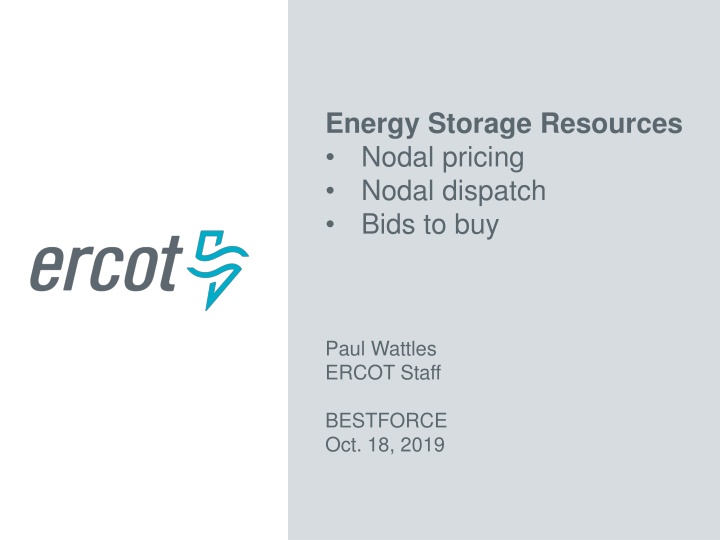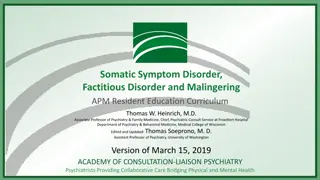Assessment of Malingering with the M-FAST
The assessment of malingering and its significance in forensic evaluations, including the theory, prevalence, reasons for malingering, when to assess, and the limitations of clinical judgment. Explore the Miller-Forensic Assessment of Symptoms Test (M-FAST) and its utility in detecting intentional symptom exaggeration. Studies highlight the importance of using objective assessment instruments over clinical judgment for accurate evaluations.
Download Presentation

Please find below an Image/Link to download the presentation.
The content on the website is provided AS IS for your information and personal use only. It may not be sold, licensed, or shared on other websites without obtaining consent from the author.If you encounter any issues during the download, it is possible that the publisher has removed the file from their server.
You are allowed to download the files provided on this website for personal or commercial use, subject to the condition that they are used lawfully. All files are the property of their respective owners.
The content on the website is provided AS IS for your information and personal use only. It may not be sold, licensed, or shared on other websites without obtaining consent from the author.
E N D
Presentation Transcript
Energy Storage Resources Nodal pricing Nodal dispatch Bids to buy Paul Wattles ERCOT Staff BESTFORCE Oct. 18, 2019
Principle Market Design Framework for Storage Resources 1. An Energy Storage Resource (ESR*) should be settled at a nodal price when either charging (withdrawing) or discharging (injecting) 2. An ESR should be active in SCED for both charging and discharging 3. SCED should dispatch an ESR on its nodal shift factor when either charging or discharging * ESR terminology as set forth in NPRR 957, endorsed by PRS 9/12/19, IA endorsed by PRS 10/10/19 2 PUBLIC
Current and future scenarios Until mid-2024, an ESR will continue to be modelled as both a Generation Resource (GR) and a Controllable Load Resource (CLR) Combo model approach The principle framework (previous slide) will be a reality when the single model approach is implemented in 2024. An ESR: Will be settled at a nodal price whether it is charging or discharging Will charge based on the equivalent of a Real-Time Energy Bid in SCED Will be dispatched by SCED on a nodal shift factor in both charge and discharge mode ERCOT is proposing to implement these concepts for the rest of the combo model era 3 PUBLIC
Background: Nodal vs. zonal pricing Under current Protocols, CLRs can participate in SCED by submitting RTM Energy Bids to buy power up to their specified price Enabled by NPRR 555, Load Resource Participation in SCED, approved by the ERCOT Board Sept. 2013 and implemented in 2014 Nodal Protocols 3.6.1 (5): The Settlement Point for a Controllable Load Resource with a Real-Time Market (RTM) Energy Bid is its Load Zone Settlement Point. 4 PUBLIC
Background: SCED participation Battery ESRs are well-suited to SCED dispatch on both the discharging (GR) and charging (CLR) sides ESR-GRs routinely participate in SCED with Energy Offer Curves SCED qualification for the CLR side of an ESR should not be a challenge To date, no ESRs have sought SCED qualification for the CLR side Instead of charging based on a Bid to buy, ESRs are changing status to OUTL and charging outside of SCED This will not be an option under the single model approach 5 PUBLIC
Background: SCED dispatch Nodal Protocols 6.5.7.3 (1): The SCED process is designed to simultaneously manage energy, the system power balance and network congestion through Resource Base Points and calculation of LMPs every five minutes. The SCED process uses a two-step methodology that applies mitigation prospectively to resolve Non-Competitive Constraints for the current Operating Hour. The SCED process evaluates Energy Offer Curves, Output Schedules and Real-Time Market (RTM) Energy Bids to determine Resource Dispatch Instructions by maximizing bid-based revenues minus offer-based costs, subject to power balance and network constraints. The SCED process uses the Resource Status provided by SCADA telemetry under Section 6.5.5.2, Operational Data Requirements, and validated by the Real-Time Sequence, instead of the Resource Status provided by the COP. An RTM Energy Bid represents the bid for energy distributed across all nodes in the Load Zone in which the Controllable Load Resource is located. Result: The ERCOT system today is designed to dispatch all CLRs including ESR CLRs based on the Load Zone shift factor This is appropriate for an Aggregated Load Resource, but not for an ESR 6 PUBLIC
ERCOTs Proposal 1. Require ESRs to be settled at a nodal price whether discharging (injecting) or charging (withdrawing) 2. Require ESRs to charge based on SCED dispatch on an RTM Energy Bid to buy This will align their behavior today with other SCED- dispatched Resources It will prepare them for the single model era, when SCED dispatch will be mandatory It will also provide ERCOT with operational visibility that it does not have today 3. Clarify that an ESR will be dispatched by SCED on its nodal shift factor whether charging or discharging 7 PUBLIC
Footnote: Wholesale Storage Load Withdrawals would be settled at a nodal price regardless of whether the ESR is receiving Wholesale Storage Load (WSL) treatment Existing ESRs with WSL treatment* would continue to receive WSL, but they would also: be required to submit RTM Bids, be dispatched on their nodal shift factor, and receive base point weighted pricing (when charging) WSL would remain an option for future ESRs with ERCOT-approved metering configurations * All ESRs today are receiving WSL treatment. 8 PUBLIC
Footnote: Settlement Only Storage This proposal would apply only to ESRs, but the concept is also appropriate for Settlement Only storage Settlement Only treatment will be addressed under different Key Concepts Settlement Only storage terminology expected to be introduced in a future RTF NPRR 9 PUBLIC
Questions? 10 PUBLIC























